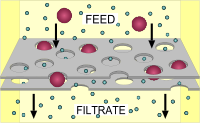
Photo from wikipedia
Abstract Thin TiOx layers were prepared by dip-coating using titanium diisopropoxide acetylacetonate (TiAcAc) precursor on different substrates and annealed at different temperatures. Atomic force microscopy, UV–Vis, FTIR and XRD spectroscopy… Click to show full abstract
Abstract Thin TiOx layers were prepared by dip-coating using titanium diisopropoxide acetylacetonate (TiAcAc) precursor on different substrates and annealed at different temperatures. Atomic force microscopy, UV–Vis, FTIR and XRD spectroscopy were used to determine thickness, morphological and structural changes with annealing temperature, including refractive index, extinction coefficient, optical band gap and removal of organic content. These differently sintered layers were used as the compact hole blocking layers in dye-sensitized and perovskite solar cells systems, keeping all other processes of cells preparation below 150 °C (including mesoporous oxides layers), simulating thus the low-T processes. Some jumps of blocking layer parameters found within sintering are related to a step increase of the efficiency of dye-senzitized cells at 150 °C, that can be useful in the low-temperature process, e.g. if TiAcAc is used as a binder of nanoparticles. However, deeper structural changes of the layers leading to higher efficiency were found out just above 350 °C. It is caused primarily by too high series resistances of low-T blocking layers that are very amorphous. So the addition of more conductive (anatase) nanoparticles into the blocking layer is much demanded. In any case, it is meaningful to use maximum acceptable temperature in the low-T process (e.g. on plastic substrates) of TiAcAc application in solar cells, where can be concluded that perovskite cells are more sensitive to defects and quality of blocking layer than dye-sensitized ones.
Journal Title: Applied Surface Science
Year Published: 2018
Link to full text (if available)
Share on Social Media: Sign Up to like & get
recommendations!